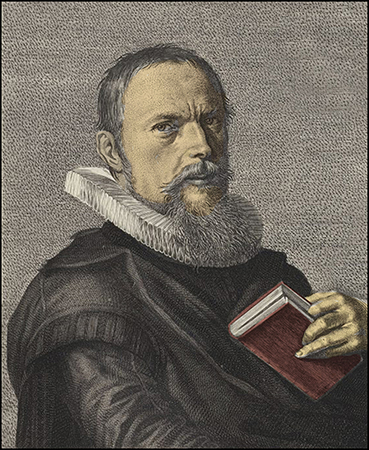This week we’ll look at another excerpt from Turbulent Tines, the new book about the Barbary corsair raids on Iceland in 1627 that my Icelandic college, Karl Smári Hreinsson, and I published this past summer.
This post tells the story of Oddur Einarsson, who became one of the most renowned bishops of Iceland (the image at the top of this post is a depiction of Oddur in his prime). It may not at first seem to have much to do with Barbary corsairs, but Oddur in fact played an important t role in the corsair raids on Iceland in the summer of 1627—as is made clear below.
I have slightly abridge the original material from the book to make it fit more easily into this post.
Iceland in the sixteenth century may have been geographically separated from Europe, but it was culturally European, and so Icelandic society was stratified. The sort of rigidly ranked, inherited nobility so common in Europe at the time, however, did not exist. There was no Icelandic king, and no hereditary noble class jealously guarding its bloodlines. There were definitely ‘haves’ and ‘have nots’, though.
The ‘haves’ were wealthy landowners, either the church or the Danish King (who was a foreign landlord), or native Icelandic gentry. The ‘have nots’ were the poor tenant farmers who worked the properties owned by the landlords. Unlike the rest of Europe, however, the divide between these two classes was relatively permeable. A poor farm boy with brains and drive had a chance of crossing over from penury to prosperity and becoming a man of importance (it was a man’s world back then, and women were mostly relegated to the role of dutiful wives and mothers). The opposite was true too, of course: misjudgment or misfortune could cause well-to-do families to slip into disgrace and poverty.
The life story of Oddur Einarsson provides an example of just this sort of crossover—in his case, it was upward mobility.

Oddur Einarsson was born on August 31, 1559, in one of the outbuildings of Möðruvallaklaustur estate in Hörgárdal, in north Iceland (about 12 kilometers/8 miles north of present-day Akureyri; see the map of north Iceland at left). Oddur’s father, Reverend Einar Sigurðsson, served as assistant to Reverend Björn Gíslason, the Officialis—Bailiff—of Möðruvallaklaustur. Oddur’s mother, Margrét Helgadóttir, worked as a maid on the estate.
Not only was Reverend Einar a pastor; he was also a renowned poet. His parish in Möðruvellir, however, was impoverished, and he and his family were little better off than the poor farmers he served.
Iceland did not have a monopoly on poverty, of course—there were poor farmers everywhere in Europe—but the harsh Icelandic climate made the hard-scrabble existence that inevitably accompanied poverty even harder. Winters in north Iceland were long and dark, summers bright but chill. The specter of famine never lay far off. Oddur would have been put to work doing farm chores almost as soon as he could walk, and he likely spent considerable time up in the hills watching over the family’s sheep, a lonely and difficult occupation for a boy.
For most boys in Oddur’s position, there was no means of escaping such a life. Oddur, however, was lucky. Möðruvallaklaustur had been an Augustinian monastery from the late thirteenth century until the Reformation came to Iceland and the Danish Crown confiscated all the Catholic monasteries in the country (over 60 in total). Möðruvallaklaustur had been an important and prosperous establishment, and even after its dissolution as a monastery, it continued to exist as a thriving estate.
Hólar, the seat of the Bishop of north Iceland, was only about 40 kilometers (25 miles) to the west (see the map of north Iceland above), and though a range of mountains separated the two, they still had a long history of interconnectedness.
All this meant that Möðruvallaklaustur remained an important place linked to important men.
Oddur’s family had connections to those men.
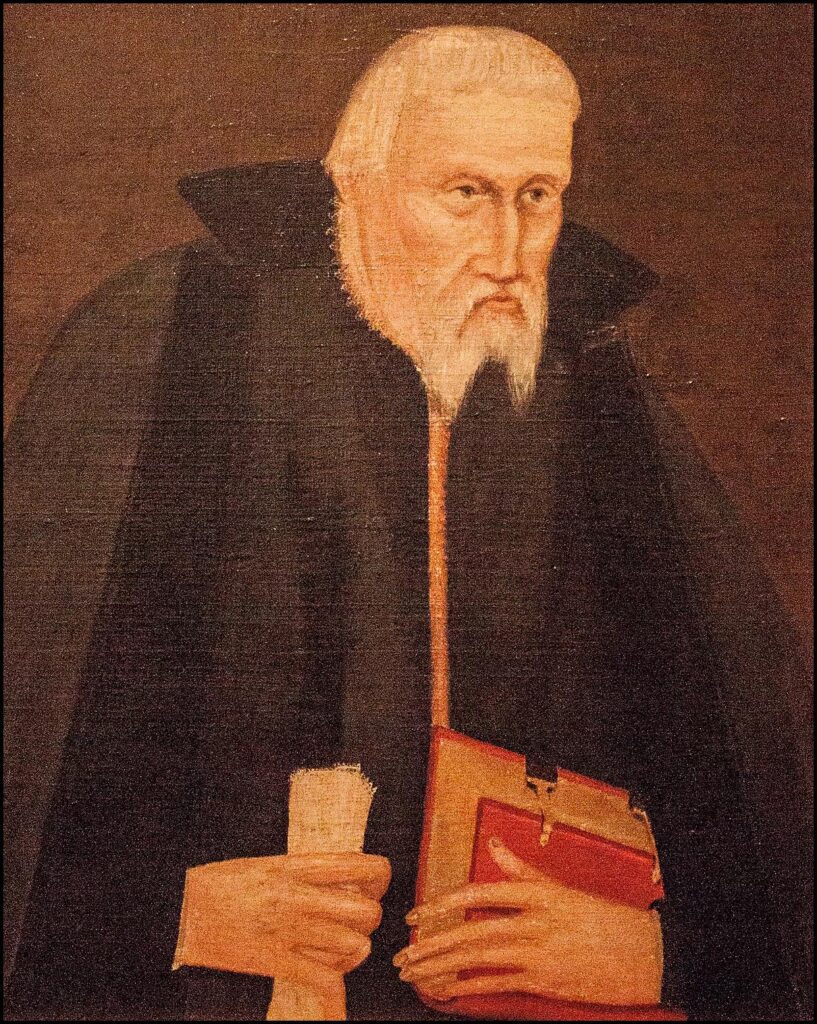
One of them was no lesser a personage than Guðbrandur Þorláksson, who had been a classmate of Oddur’s father in Holaskóli, and who would become Bishop of north Iceland in 1571, a position he held until his death in 1627 (see the portrait of Bishop Guðbrandur at left, which depicts him as he looked towards the end of his tenure). Another was Reverend Björn Gíslason, the Bailiff of Möðruvallaklaustur estate.
Oddur’s father knew the only way for any of his sons to escape the trap of poverty was to get an education—which meant attending Hólaskóli (Hólar’s school), since it was the only school in the area. Guðbrandur Þorláksson (he who would become Bishop) served as Headmaster at Holaskóli from 1569 to 1570, and this no doubt eased the process of getting Odur accepted into the school.
Like many parents, however, Reverend Einar lacked the means to finance his children’s education. Fortunately, Reverend Björn, the Bailiff of Möðruvallaklaustur Estate, stepped in and offered the necessary financial support.
So Oddur attended Hólaskóli, starting around the age of perhaps ten (and likely having had some home schooling already from his father). He turned out to be an excellent student, but it was not until 1583, when he was twenty-four, that Oddur was finally able to go to Denmark to study at the University of Copenhagen. This was late for a bright young student such as he. Most of the students from Holaskóli and Skálholtsskóli who went on to the University of Copenhagen did so in their late teens. The obvious explanation for this delay is lack of funds.
Somehow, though, whether through the intervention of Guðbrandur Þorláksson (who by then had been Bishop for over a decade), the continuing financial support from Reverend Björn Gíslason the Bailiff, or through support from other well-off family connections, Oddur was finally able to further his education. The delay must have been a source of acute frustration for him.
Oddur went to Copenhagen to be educated as a pastor and follow his father’s vocation. However, he studied not only theology, but also subjects such as mathematics and astronomy. Towards the end of his studies (or perhaps after he graduated; the sources are unclear), he spent some considerable time on the island of Hven—located near Copenhagen in the Øresund, the narrow straight separating Denmark and Sweden—where the famous astronomer Tycho Brahe had his observatory.

Oddur was as outstanding a student at the University of Copenhagen as he had been at Holaskóli, which was no doubt how he gained the privilege of studying under the great astronomer. And privilege it was. When Oddur went to Hven, Tycho Brahe was one of the towering figures of Denmark. Studying under him was no doubt difficult, though. Brahe came from the Danish nobility, and he had the arrogance and sense of entitlement all too common among such men of privilege. (That arrogance is caught quite well in the portrait of him at left).
Having received Hven as a royal grant from the Danish King, Brahe ruled over the island like a medieval feudal lord. He was irascible, impatient, and egotistical—and constantly squabbling with neighbors and tenants over rents and privileges. But he was also brilliant, and driven, and totally dedicated to his work. At the time, there was no better person to study math, navigation, or astronomy under.
When Oddur arrived on Hven, Tycho Brahe had been ensconced there for six or seven years. With the royal financing he received, the great astronomer had built an observatory from which to make long-term, meticulously accurate observations of the night sky—something nobody at that time had yet done.
The observatory, known as Uraniborg (“The Castle of Urania,” Urania being the Greek goddess of astronomy and the stars), was a massive structure—more castle, really, than observatory—in which nearly a hundred students, apprentices, and artisans toiled, Oddur among them.
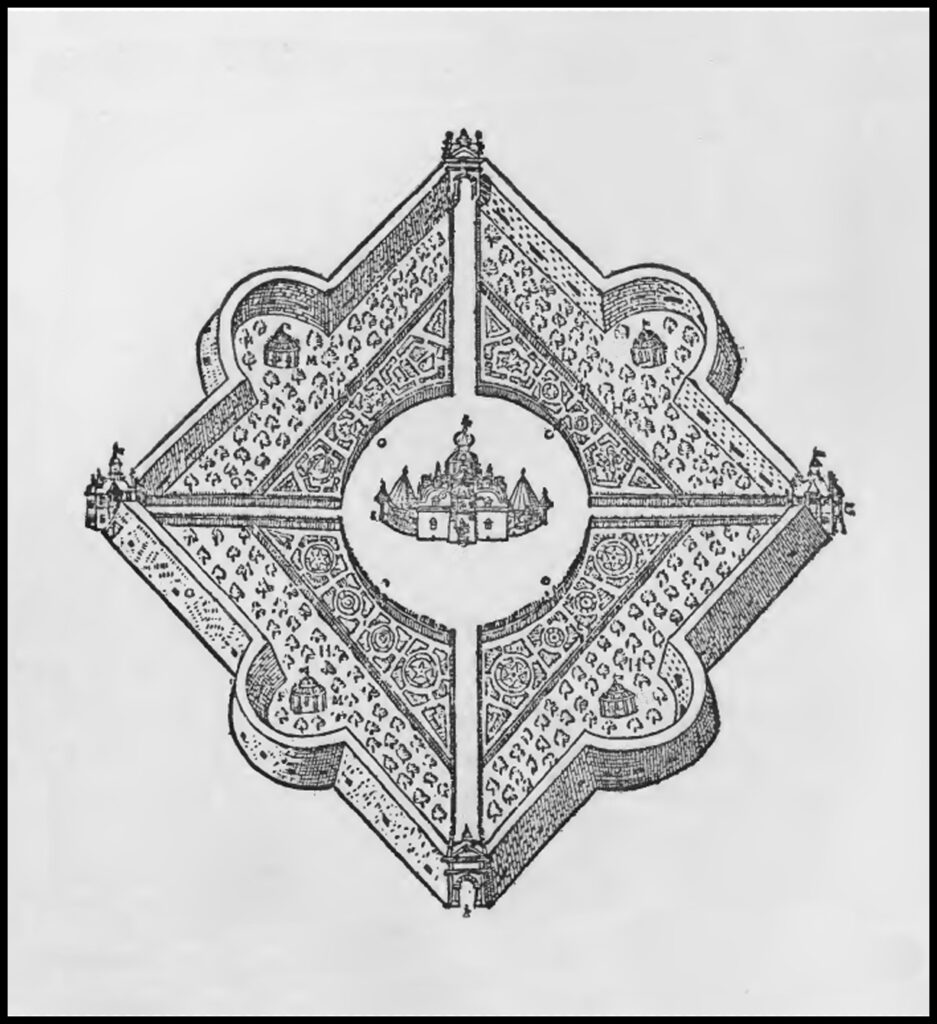
The building was surrounded by carefully arranged and tended gardens and orchards that were enclosed by an impressive, square earthen wall sheathed in stone that was 75 meters (250 feet) on a side, 5.5 meters (18 feet) high, and 5 meters (16 feet) thick at the base (see the illustration at left).
The remnant of this earthen wall is the only sign that remains of the place today (see the satellite image at left below, which shows what Uraniborg looks like today).
Each corner of the long, enclosing walls contained a gatehouse in which English mastiffs were kept to alert the gatekeepers to the arrival of visitors. Within the walls were several smaller buildings—including a paper mill and a printing press (Brahe published his own work)—but it was Uraniborg itself that dominated everything.
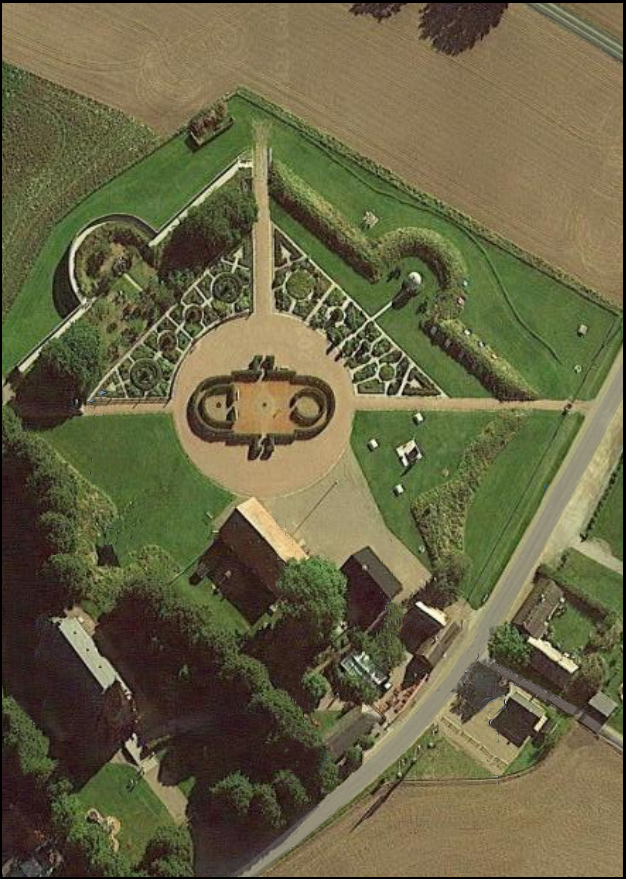
Built primarily of red brick, and more than three stories tall, it sat like a giant, uncut ruby in an emerald setting. Towers on the sides of the main building featured observation decks for star gazing. At the very top of the structure sat a cupola that included a sort of ‘widow’s walk’ from where more observation could be made (see the illustration at left below).
Inside, were galleries, a library, and numerous rooms (including a garret on the top floor, just below the cupola, divided into chambers for students). Brahe’s interests included more than just astronomy, and the cellar held retorts and other esoteric laboratory equipment for alchemical experiments.
It is not hard to imagine Oddur’s reaction the day he first set foot on Hven.
He would have taken a boat from Copenhagen across the sound and disembarked at the harbor on the island’s western shore. From there, it was a walk of about a kilometer and a half (slightly under a mile) to Uraniborg, located in the middle of the island.
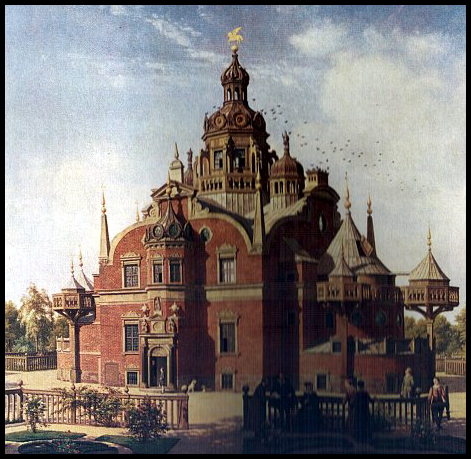
Oddur would have seen the large earthen wall in the distance, with the upper part of Uraniborg rising above it. Entering through one of the gates—the English mastiffs no doubt greeting him with a strident chorus of barking—he would have had his first unobstructed view of the imposing building where Tycho Brahe conducted his work.
Iceland in Oddur’s time had no cities, few large buildings, and even fewer built entirely of stone. His years in Copenhagen must have familiarized him with stone architecture, but, even so, Oddur no doubt stood there, gazing up at that huge, elegant, famous building, overcome by excitement, anticipation, and sheer awe.
Unfortunately, we know very little about Oddur’s time at Uraniborg. His experience there clearly made a lasting impression upon him, though. The whole point of Uraniborg was to make careful, long-term observations of the night sky. This does not sound particularly radical today, but for the time, it was revolutionary.
The Middle Ages had been obsessed with the spiritual. By Oddur’s day, a profound shift was occurring, and Europeans were more and more preoccupied with observing the natural world, recording their observations, and—crucially—using those observations to explain and predict events. Oddur clearly absorbed this ‘naturalist’ approach, and his time at Hven instilled in him a lifelong fascination with what we today would call mathematics, astronomy, geography, and history—especially history.
Oddur’s time in Copenhagen—and Hven—was a watershed experience, the sort of thing that rarely happens more than once in a lifetime, and usually to the young. It marked him for the rest of his life.
Upon his return to Iceland, Oddur became Headmaster at Hólaskóli. Shortly after that, thanks to the support of Bishop Guðbrandur, Oddur became Bishop of south Iceland and settled in Skálholt, the Bishop’s official residence. He was just thirty years old.
The Bishops of Iceland were important men. Oddur—now well educated, well connected, and ambitious—had risen from being a poor shepherd boy to being one of the Iceland’s most influential men.
Oddur remained the Bishop at Skálholt of for over forty years. During his decades in office, he fulfilled his religious duties as Bishop, but thanks to the enduring effect of his experiences in Copenhagen, he also pursued an educational agenda, writing books himself, sponsoring books written by others, and acquiring an extensive collection of manuscripts—all with the goal of accurately recording Icelandic history and culture (as Tycho Brahe had accurately recorded the positions of the stars).
By the summer of 1627, when Barbary corsairs from Salé and Algiers raided the island, Oddur had been Bishop for thirty-eight years. He was, possibly, the most influential man in Iceland at the time.
All the people taken captive in the corsair raids were his parishioners, and he became involved in a number of ways—one of them being to oversee the creation of narratives and written reports about the events of the raids.
No other Barbary corsair land raid of the time is recorded in as much detail as the Iceland raids of 1627 are. It is only thanks to the influence of Bishop Oddur—by that time the venerable Bishop Oddur—that we have these extensive written records. Without Oddur, we would know far less about the corsair raids of 1627.
Sometimes, a single person can make all the difference.

Corsairs and Captives
Narratives from the Age of the Barbary Pirates
View Amazon listing
The Travels of Reverend Ólafur Egilsson
The story of the Barbary corsair raid on Iceland in 1627
View Amazon listing